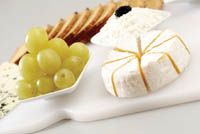Say Cheese!
Get the party started with a picture-perfect plate of artisanal delights
 Making a great cheese plate can be simple and easy. Choose a group of three to six cheeses and arrange them from mildest to strongest, placing the first cheese to be tasted (the mildest) at 6 o’clock. The cheeses should be evenly spaced and fit within the border of the plate. It is especially effective to alternate textures where possible while keeping the progression in mind.
Making a great cheese plate can be simple and easy. Choose a group of three to six cheeses and arrange them from mildest to strongest, placing the first cheese to be tasted (the mildest) at 6 o’clock. The cheeses should be evenly spaced and fit within the border of the plate. It is especially effective to alternate textures where possible while keeping the progression in mind.
HOW MUCH CHEESE TO PURCHASE
You will need to buy more cheese if you are serving it as an hors d’oeuvre at a cocktail reception or on a buffet as opposed to cheeses that you will slice and serve individually. Follow these guidelines to determine how much cheese you will need per person:
Hors d’oeuvres (before dinner): 4 to 6 ounces
Hors d’oeuvres (cocktail party): 5 to 6 ounces
Appetizer course: 3 to 4 ounces
Main course: 5 to 6 ounces
Cheese plate: 2 to 3 ounces
PRESENTATION
For a visually appealing platter, select three to six cheeses that vary in shape, size and color.
TEXTURE
Choose cheeses from soft and runny to firm and crumbly. For example, a ripe and runny Camembert, aged Gouda and blue cheese create nice textural contrast.
MILK TYPE
Select cheeses made from the three main milk types: goat, sheep and cow.
FLAVOR
Select cheeses that have different flavor profiles, ranging from mild to strong.
THEME
You might choose to develop a theme around your presentation (for instance, serve all firm mountain cheeses, all blues or cheeses from the same region or by the same cheesemaker). A goat-cheese tasting is another great theme: Include goat’s milk cheeses from several countries, varying in texture and pungency.
WINE
Rarely will one wine complement several cheeses at once. Serve two varietals: a Sauvignon Blanc or Pinot Gris would be a good white choice, and a mediumbodied Cabernet Sauvignon or Pinot Noir would be a fine red.
ACCOMPANIMENTS AND CONDIMENTS
Serve cheese very simply with little fuss. Let the cheeses stand alone and display their natural beauty. Add fresh, seasonal fruits, nuts, figs or perhaps a chutney (to go with a fine English cheddar for instance). Crusty bread and Medjool dates are simple additions that complement all cheese types. A selection of olives, roasted peppers, peppadews and tomatoes are a good match for fresh goat cheeses.
CHOOSE YOUR SURFACE
Opt for a beautiful plate, rustic board or earthy marble or stone platter.
BEFORE SERVING
Make sure you remove your cheeses from the refrigerator in time for them to come to room temperature, approximately an hour and a half, depending on the temperature of your room. Keep the cheeses wrapped until ready to serve.
CUTLERY
Use a different knife or spoon (for the runny types!) for each cheese. I find that butter knives are a good choice because they don’t take up a whole lot of space on your platter.
SLICING CHEESE
If you would like to slice cheeses for your guests in advance, here are some techniques and guidelines to follow:
- Round cheeses, such as Camembert, Reblochon or Pierre Robert should be cut in half and then into small triangle wedges.
- Larger firm cheeses should be cut into wedges and placed on their side to be sliced.
- Square cheeses can be cut diagonally and then into smaller triangle wedges.
- Soft, runny cheeses can be left in their box and guests can use a spoon to scoop the soft cheese onto a cocktail plate or a slice of baguette. To serve a whole soft Spanish cheese, make a circular lid by cutting off the top and serving the cheese in its own “bowl” with a spoon. Save the lid and use to cover any leftover cheese.
- Use a sharp chef’s knife for semisoft to hard cheeses.
Most important, have fun and enjoy all the flavors, textures and aromas that artisanal cheeses have to offer!
